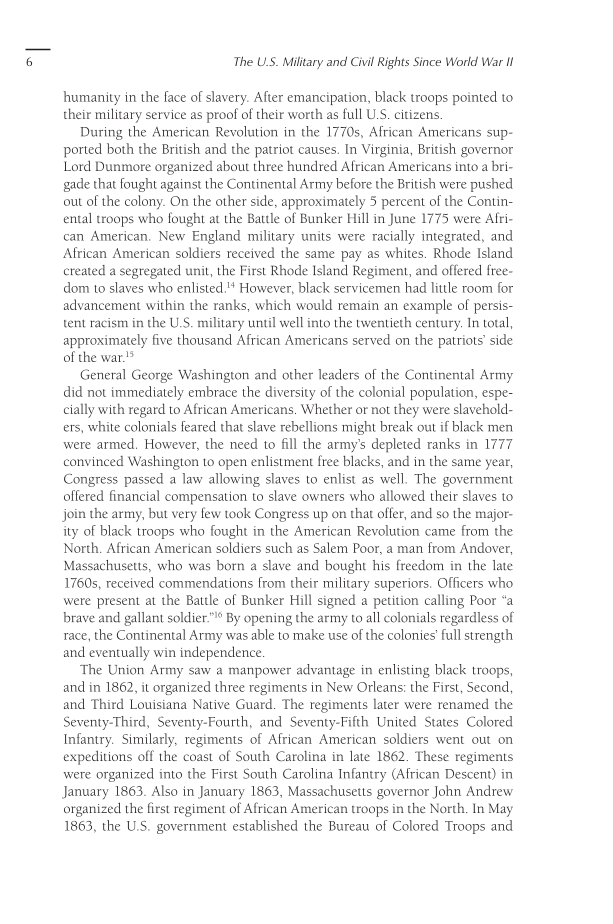6 The U.S. Military and Civil Rights Since World War II humanity in the face of slavery. After emancipation, black troops pointed to their military service as proof of their worth as full U.S. citizens. During the American Revolution in the 1770s, African Americans sup- ported both the British and the patriot causes. In Virginia, British governor Lord Dunmore organized about three hundred African Americans into a bri- gade that fought against the Continental Army before the British were pushed out of the colony. On the other side, approximately 5 percent of the Contin- ental troops who fought at the Battle of Bunker Hill in June 1775 were Afri- can American. New England military units were racially integrated, and African American soldiers received the same pay as whites. Rhode Island created a segregated unit, the First Rhode Island Regiment, and offered free- dom to slaves who enlisted.14 However, black servicemen had little room for advancement within the ranks, which would remain an example of persis- tent racism in the U.S. military until well into the twentieth century. In total, approximately five thousand African Americans served on the patriots’ side of the war.15 General George Washington and other leaders of the Continental Army did not immediately embrace the diversity of the colonial population, espe- cially with regard to African Americans. Whether or not they were slavehold- ers, white colonials feared that slave rebellions might break out if black men were armed. However, the need to fill the army’s depleted ranks in 1777 convinced Washington to open enlistment free blacks, and in the same year, Congress passed a law allowing slaves to enlist as well. The government offered financial compensation to slave owners who allowed their slaves to join the army, but very few took Congress up on that offer, and so the major- ity of black troops who fought in the American Revolution came from the North. African American soldiers such as Salem Poor, a man from Andover, Massachusetts, who was born a slave and bought his freedom in the late 1760s, received commendations from their military superiors. Officers who were present at the Battle of Bunker Hill signed a petition calling Poor “a brave and gallant soldier.”16 By opening the army to all colonials regardless of race, the Continental Army was able to make use of the colonies’ full strength and eventually win independence. The Union Army saw a manpower advantage in enlisting black troops, and in 1862, it organized three regiments in New Orleans: the First, Second, and Third Louisiana Native Guard. The regiments later were renamed the Seventy-Third, Seventy-Fourth, and Seventy-Fifth United States Colored Infantry. Similarly, regiments of African American soldiers went out on expeditions off the coast of South Carolina in late 1862. These regiments were organized into the First South Carolina Infantry (African Descent) in January 1863. Also in January 1863, Massachusetts governor John Andrew organized the first regiment of African American troops in the North. In May 1863, the U.S. government established the Bureau of Colored Troops and
Document Details My Account Print multiple pages
Print
You have printed 0 times in the last 24 hours.
Your print count will reset on at .
You may print 0 more time(s) before then.
You may print a maximum of 0 pages at a time.














































































































































































